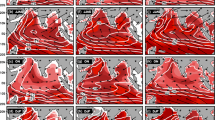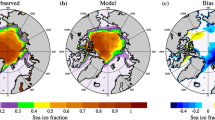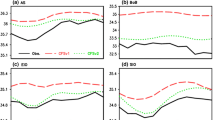Abstract
The effect of increasing atmospheric resolution on prediction skill of El Niño southern oscillation phenomenon in climate forecast system model is explored in this paper. Improvement in prediction skill for sea surface temperature (SST) and winds at all leads compared to low resolution model in the tropical Indo-Pacific basin is observed. High resolution model is able to capture extreme events reasonably well. As a result, the signal to noise ratio is improved in the high resolution model. However, spring predictability barrier (SPB) for summer months in Nino 3 and Nino 3.4 region is stronger in high resolution model, in spite of improvement in overall prediction skill and dynamics everywhere else. Anomaly correlation coefficient of SST in high resolution model with observations in Nino 3.4 region targeting boreal summer months when predicted at lead times of 3–8 months in advance decreased compared its lower resolution counterpart. It is noted that higher variance of winds predicted in spring season over central equatorial Pacific compared to observed variance of winds results in stronger than normal response on subsurface ocean, hence increases SPB for boreal summer months in high resolution model.














Similar content being viewed by others
References
Ajaya Mohan RS, Goswami BN (2003) Potential predictability of the Asian summer monsoon on monthly and seasonal time scales. Meteorol Atmos Phys 84:83–100. https://doi.org/10.1007/s00703-002-0576-4
Bamston AG, Chelliah M, Goldenberg SB (1997) Documentation of a highly ENSO-related sst region in the equatorial pacific: research note. Atmos Ocean 35:367–383. https://doi.org/10.1080/07055900.1997.9649597
Barnston AG, Tippett MK (2013) Predictions of Nino3.4 SST in CFSv1 and CFSv2: a diagnostic comparison. Clim Dyn 41:1615–1633. https://doi.org/10.1007/s00382-013-1845-2
Barnston AG, Tippett MK, L’Heureux ML et al (2012) Skill of real-time seasonal ENSO model predictions during 2002–11: is our capability increasing? Bull Am Meteorol Soc 93:631–651. https://doi.org/10.1175/BAMS-D-11-00111.1
Carton JA, Chepurin G, Cao X, Giese B (2000) A simple ocean data assimilation analysis of the global upper ocean 1950–95. Part I: methodology. J Phys Oceanogr 30:294–309. https://doi.org/10.1175/1520-0485(2000)030<0294:ASODAA>2.0.CO;2
Chen D, Cane MA, Kaplan A et al (2004) Predictability of El Niño over the past 148 years. Nature 428:733–736. https://doi.org/10.1038/nature02439
Dai A (2006) Precipitation characteristics in eighteen coupled climate models. J Clim 19:4605–4630. https://doi.org/10.1175/JCLI3884.1
Dee DP, Uppala SM, Simmons AJ et al (2011) The ERA-Interim reanalysis: configuration and performance of the data assimilation system. Q J R Meteorol Soc 137:553–597. https://doi.org/10.1002/qj.828
Duan W, Wei C (2013) The “spring predictability barrier” for ENSO predictions and its possible mechanism: results from a fully coupled model. Int J Climatol 33:1280–1292. https://doi.org/10.1002/joc.3513
Ek MB, Mitchell KE, Lin Y et al (2003) Implementation of Noah land surface model advances in the National Centers for Environmental Prediction operational mesoscale Eta model. J Geophys Res 108:8851. https://doi.org/10.1029/2002JD003296
Goswami BN, Shukla J (1991) Predictability of a coupled ocean–atmosphere model. J Clim 4:3–22
Goswami BN, Xavier PK (2005) ENSO control on the south Asian monsoon through the length of the rainy season. Geophys Res Lett 32:2005–2007. https://doi.org/10.1029/2005GL023216
Griffies SM, Harrison MJ, Pacanowski RC, Rosati A (2004) A technical guide to MOM4. GFDL Ocean Group Tech Rep 5:371
Gualdi S, Alessandri A, Navarra A (2005) Impact of atmospheric horizontal resolution on El Niño 3.4 southern oscillation forecasts. Tellus Ser A Dyn Meteorol Oceanogr 57:357–374. https://doi.org/10.1111/j.1600-0870.2005.00108.x
Guilyardi E, Gualdi S, Slingo J et al (2004) Representing El Niño in coupled ocean–atmosphere GCMs: the dominant role of the atmospheric component. J Clim 17:4623–4629. https://doi.org/10.1175/JCLI-3260.1
Hurwitz MM, Calvo N, Garfinkel CI et al (2014) Extra-tropical atmospheric response to ENSO in the CMIP5 models. Clim Dyn 43:3367–3376. https://doi.org/10.1007/s00382-014-2110-z
Kirtman BP, Schopf PS (1998) Decadal variability in ENSO predictability and prediction.J Clim 11:2804–2822. https://doi.org/10.1175/1520-0442(1998)011<2804:DVIEPA>2.0.CO;2
Kleeman R, Power SB (1994) Limits to predictability in a coupled ocean–atmosphere model due to atmospheric noise. Tellus A 46:529–540. https://doi.org/10.1034/j.1600-0870.1994.00014.x
Kumar A, Jha B, L’Heureux M (2010) Are tropical SST trends changing the global teleconnection during La Niña? Geophys Res Lett. https://doi.org/10.1029/2010GL043394
Kumar A, Chen M, Zhang L et al (2012) An analysis of the nonstationarity in the bias of sea surface temperature forecasts for the NCEP climate forecast system (CFS) version 2. Mon Weather Rev 140:3003–3016. https://doi.org/10.1175/MWR-D-11-00335.1
Kumar A, Hu ZZ, Jha B, Peng P (2017) Estimating ENSO predictability based on multi-model hindcasts. Clim Dyn 48:39–51. https://doi.org/10.1007/s00382-016-3060-4
Madden RA, Julian PR (1994) Observations of the 40–50-day tropical oscillation—a review. Mon Weather Rev 122:814–837. https://doi.org/10.1175/1520-0493(1994)122<0814:OOTDTO>2.0.CO;2
Marshall AG, Alves O, Hendon HH (2009) A coupled GCM analysis of MJO activity at the onset of El Niño. J Atmos Sci 66:966–983. https://doi.org/10.1175/2008JAS2855.1
Nanjundiah RS, Francis PA, Ved M, Gadgil S (2013) Predicting the extremes of Indian summer monsoon rainfall with coupled ocean atmosphere models. Curr Sci 104:1380–1393
Pillai PA, Rao SA, Das RS et al (2017) Potential predictability and actual skill of boreal summer tropical SST and Indian summer monsoon rainfall in CFSv2-T382: role of initial SST and teleconnections. Clim Dyn (online):1–18. https://doi.org/10.1007/s00382-017-3936-y
Pokhrel S, Chaudhari HS, Saha SK et al (2012) ENSO, IOD and Indian summer monsoon in NCEP climate forecast system. Clim Dyn 39:2143–2165. https://doi.org/10.1007/s00382-012-1349-5
Ramu DA, Rao SA, Pillai PA et al (2017) Prediction of seasonal summer monsoon rainfall over homogenous regions of India using dynamical prediction system. J Hydrol 546:103–112. https://doi.org/10.1016/j.jhydrol.2017.01.010
Reynolds RW, Smith TM, Liu C et al (2007) Daily high-resolution-blended analyses for sea surface temperature. J Clim 20:5473–5496. https://doi.org/10.1175/2007JCLI1824.1
Rowell DP (1998) Assessing potential seasonal predictability with an ensemble of multidecadal GCM simulations. J Clim 11:109–120. https://doi.org/10.1175/1520-0442(1998)011<0109:APSPWA>2.0.CO;2
Saha S, Moorthi S, Pan HL et al (2010) The NCEP climate forecast system reanalysis. Bull Am Meteorol Soc 91:1015–1057. https://doi.org/10.1175/2010BAMS3001.1
Saha S, Moorthi S, Wu X et al (2014) The NCEP climate forecast system version 2. J Clim 27:2185–2208. https://doi.org/10.1175/JCLI-D-12-00823.1
Torrence C, Webster PJ (1998) The annual cycle of persistence in the El Nino southern oscillation. Q J R Meteorol Soc 124:1985–2004
Wang B, Rui H (1990) Synoptic climatology of transient tropical intraseasonal convection anomalies: 1975–1985. Meteorol Atmos Phys 44:43–61. https://doi.org/10.1007/BF01026810
Wang W, Saha S, Pan H-L et al (2005) Simulation of ENSO in the new NCEP coupled forecast system model (CFS03). Mon Weather Rev 133:1574–1593. https://doi.org/10.1175/MWR2936.1
Whitaker JS, Loughe AF (1998) The relationship between ensemble spread and ensemble mean skill. Mon Weather Rev 126:3292–3302. https://doi.org/10.1175/1520-0493(1998)126<3292:TRBESA>2.0.CO;2
Winton M (2000) A reformulated three-layer sea ice model. J Atmos Ocean Technol 17:525–531. https://doi.org/10.1175/1520-0426(2000)017<0525:ARTLSI>2.0.CO;2
Xue Y, Huang B, Hu ZZ et al (2011) An assessment of oceanic variability in the NCEP climate forecast system reanalysis. Clim Dyn 37:2511–2539. https://doi.org/10.1007/s00382-010-0954-4
Yu JY, Kao HY (2007) Decadal changes of ENSO persistence barrier in SST and ocean heat content indices: 1958–2001. J Geophys Res Atmos. https://doi.org/10.1029/2006JD007654
Yu Y, Duan W, Xu H, Mu M (2009) Dynamics of nonlinear error growth and season-dependent predictability of El Niño events in the Zebiak–Cane model. Q J R Meteorol Soc 135:2146–2160. https://doi.org/10.1002/qj.526
Zebiak SE, Cane MA (1987) A model El Nino-southern oscillation. Mon Weather Rev 115:2262–2278
Zhang L, Kumar A, Wang W (2012) Influence of changes in observations on precipitation: a case study for the climate forecast system reanalysis (CFSR). J Geophys Res Atmos. https://doi.org/10.1029/2011JD017347
Zheng Z, Hu Z-Z, L’Heureux M (2016) Predictable components of ENSO evolution in real-time multi-model predictions. Sci Rep 6:35909. https://doi.org/10.1038/srep35909
Acknowledgements
The Indian Institute of Tropical Meteorology (IITM) is fully funded by the Ministry of Earth Sciences (MoES), Government of India, New Delhi. First author would like to thank Mr. Siddharth Kumar for his help in editing final version of manuscript. Authors thank NCEP for making available CFS model output for analysis and for transferring the CFS system under the MoU among the Ministry of Earth Science (MoES), Govt. of India and NCEP. Authors thank NCAR for making available the NCL software. We thank two anonymous reviewers for their constructive comments. It helped a lot in improving the manuscript. All the data sources are duly acknowledged.
Author information
Authors and Affiliations
Corresponding author
Ethics declarations
Conflict of interest
The authors declare that they have no conflict of interest.
Rights and permissions
About this article
Cite this article
Arora, A., Rao, S.A., Pillai, P. et al. Assessment of prediction skill in equatorial Pacific Ocean in high resolution model of CFS. Clim Dyn 51, 3389–3403 (2018). https://doi.org/10.1007/s00382-018-4084-8
Received:
Accepted:
Published:
Issue Date:
DOI: https://doi.org/10.1007/s00382-018-4084-8




